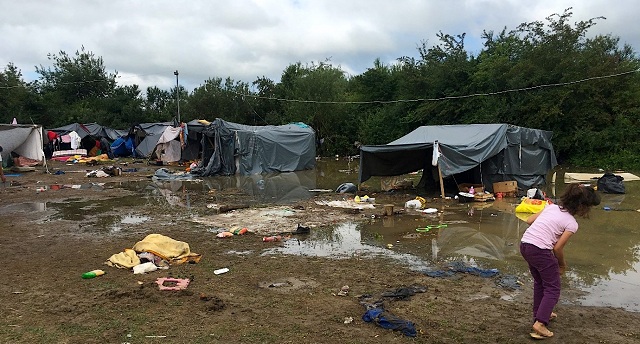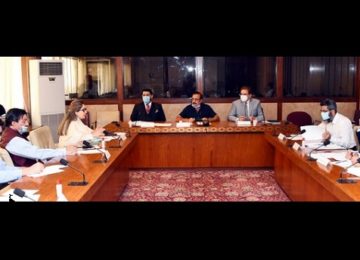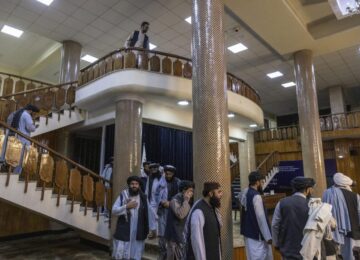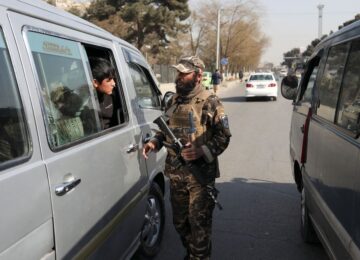Since January, around 800 Afghans have arrived in the non-EU country of Bosnia and Herzegovina, in an attempt to find a new route into the European Union. They are mainly camping out in dilapidated buildings and makeshift structures in the towns of Bihać and Velika Kladuša, both near to the north-western border with EU member Croatia. Border patrols seek to prevent them from travelling any further. Although some of the Afghans are new arrivals in the Balkans, others have been stranded in neighbouring Serbia for over two years and have recently come to Bosnia. AAN guest author Elizabeth Wait (*) brings rare insights into a journey of an underreported group of Afghans stuck in Bosnia.
At any one time, you can see twenty or so Afghans pacing up and down the kilometre stretch of road that connects the main informal camp for migrants in Velika Kladuša to the town centre. They pace without purpose.
Intermittently, they break off their walking to perch on the steps in front of shops to ‘people watch’ and connect to the WiFi belonging to a nearby café. “We just walk,” one man, a Pashtun from Nangrahar said, “we have no work, we have nothing, we are refugees.” With no realistic chance of getting into the EU, Afghans who do not have enough money to pay smugglers are left, as they say gaurzai-ra gaurzai – walking back and forth – killing time as they cling to the hope that a better future, somehow, awaits.
This dispatch will look at how and why Afghans are now gathering in Bosnia and Herzegovina and what are their prospects. (1) After looking at the situation in Sarajevo, Bosnia’s capital, the landing spot for migrant arrivals, the author draws on observations she made during a trip to two northern towns close to the border with EU member state, Croatia, where the majority of migrants reside. Some of the Afghan migrants in Bosnia lack money to pay smugglers to help them move into the EU. Still, they keep trying to ‘play the game’ – in Dari, game zadan– slang for trying to cross a border without papers. The majority who succeed in crossing the border end up ‘pushed back’ into Bosnia, with male migrants consistently alleging they have been beaten by the Croatian police. Most of the Afghans are single men, mainly Pashtun, but there are a small percentage of families – maybe 15 per cent of the total. Of these, a handful are Hazaras and the majority are Tajik.
An overview: Why come to Bosnia and Herzegovina?
The arrival of Afghans, as well as Syrians, Pakistanis, Iraqis, Iranians and other migrants and refugees to Bosnia and Herzegovina is a relatively recent phenomenon. The first noticeable influx of migrants in the country was detected in the first six months of 2018; the United Nation’s Refugee agency, UNHCR recorded the entry of over 7,600 refugees and migrants to Bosnia in that period. 12 per cent were Afghans. (2) The aim for most migrants is to travel undetected through Croatia and then Slovenia to reach Italy, which is more prosperous and, as yet, more welcoming to those seeking asylum.
In a research study conducted in May 2018, Refugee Aid Serbia (RAS) recorded that 80 percent of the migrants arriving into Bosnia had come from its neighbour to the east, Serbia (see this in-depth analysis here). Remaining 20 percent had arrived from Montenegro to the south.
Of those coming from Serbia, some had recently arrived there from Greece or Turkey, the two countries that host significant number of Afghan and other refugees (via Bulgaria, or Macedonia or Kosovo). These migrants had only spent a few days in Serbia before coming on to Bosnia. Others were among the 7,000 refugees, mainly Afghan, who have been stranded in Serbia since the closure of the ‘Balkan Corridor’ in March 2016. This was the temporary legalised pathway that allowed Syrians, Afghans and Iraqis to bypass border controls after German Chancellor Angela Merkel announced a welcome to Syrian refugees in November 2015. It was shut five months later, in March 2016 (See this AAN dossier on Afghan migration to Europe). (3)
As AAN reported in 2017, Afghans trapped in Serbia do not generally want to be there and few claim asylum. Getting out of Serbia to an EU country, either Hungary to the north or Croatia to the west is extremely difficult, though. (4) Coming to Bosnia then for Afghan migrants, represents just a new attempt to find a way through to the EU. However, as this dispatch will show, it offers only slighter better prospect of getting to the EU than Serbia. However, particularly for migrants without the resources to pay smugglers, that slight advantage is enough to bring them to Bosnia.
Whether hoping to settle in Italy or to travel onwards to another country in western or northern Europe, Afghans aim to pass the police spread along the land route from north-western Bosnia to north-eastern Italy, including in Croatia and Slovenia. Only a small percentage of people are lucky enough to slip past the surveillance of the Croatian forces, which are reported to be equipped, along the border, with 150 cameras, a helicopter, night-vision drones, guard dogs and snipers. The EU is planning to triple its spending on border-protection measures, meaning it will only become increasingly harder, if not impossible, to pass through undetected in the future.
Getting from Serbia to Bosnia
As an aid-worker who worked in the Serbian capital Belgrade and in Subotica, a town in Serbia on the border with Hungary between September 2017 and June 2018, this author saw how migrants abandoned attempts to cross into Hungary and other routes out of Serbia. Instead, in January of this year, they started crossing into Bosnia. Phone calls between groups of friends split between the two countries went back and forth and almost always resulted in more migrants embarking on the journey west to Bosnia.
Between January and March 2018, a little over 1,300 migrants arrived in Bosnia. The number of new arrivals to Bosnia increased significantly in April 2018 and reached a peak in early May when an estimated 400 migrants were arriving daily. This resulted, in total, in more than 6,250 new arrivals in Bosnia between April and June.
The Bosnian government tried to clamp down on the route around April when it realised that the local authorities and the only state-run migrant facility at that time, the Asylum Centre in Delijaš, a town 40 kilometres from the Bosnia capital, Sarajevo, were unable to accommodate the influx of new arrivals. However, by May 2018 there were so many people in the Bosnian capital, many had no option but to sleep rough in the park near the City Hall. The NGO, Refugees Aid Serbia (RAS), assessed that in mid-May, there were around 1,000 migrants and refugees in and around Sarajevo (see here). It also reported:
These figures include the asylum facility in Delijaš outside Sarajevo where between 120 and 150 migrants/refugees are sheltered; UNHCR-sponsored hotels/hostels which then accommodate up to 400 beneficiaries; accommodation provided by volunteers and locals, where around 120 people are sheltered; up to 350 migrants/refugees residing in the park near the City Hall, and an unknown number of those sleeping in squats around Sarajevo, which is not below 100.
Out of the 350 people sleeping rough, the NGO reported that 40 per cent were women and 14 per cent were children under the age of 16. This situation was a wake-up call to the government, (see here). In a matter of a few week, the EU provided funding for the Refugee Reception Centre in Salakovac, a village two hours west of the capital, near the city of Mostar. On 18 May 2018, local police forces took 270 migrants from Sarajevo to the newly-opened centre (see here). Nevertheless, like the Asylum Centre in Delijaš, spaces were primarily allocated to families with young children and in both centres, there was capacity for fewer than 400 migrants.
The decision to prioritise families with young children, in combination with the general shortage of accommodation, meant that almost all the single men were forced to continue to sleep rough. The many single men that did not get a place in the shelters moved to be closer to the only food distribution that continued after 18 May 2018, this was carried out twice a day by an unnamed group of international volunteers at the Sarajevo Central Railway Station (see here). The swift departure of migrants from the park near the City Hall was also linked, some local volunteers told AAN, with Turkish President Recep Tayyip Erdogan’s visit to Sarajevo on 20 May 2018. Erdogan was to be walking through the area with the Bosniak member of the tripartite presidency of Bosnia and Herzegovina, Bakir Izetbegovic and, the volunteers believed, the authorities did not want the ‘unsightly’ migrant camp to be on show.
In mid-June and at a time when donations were dwindling, the author met men hanging around the railway station. At night, at any one time, 150 or so migrants were sleeping in the sheltered crevasses of the train station building or behind the backs of similarly large buildings on nearby streets. Although the same group of international volunteers tried to distribute sleeping materials, the lack of donations had meant that migrants were being given only one thin blanket each, or a thick blanket between three. It was not enough. Sarajevo is located in a mountain gorge and therefore typically reaches much colder temperatures than other areas of the country. This desperate setting led migrants to accelerate their attempts to get to the country’s northern border with Croatia and be nearer to the EU.
Waiting in the north to cross the border
Most migrants want to get to the north of Bosnia, which is closer to the border with Croatia. They include families who had been housed in either the Salakovac or Delijaš reception and asylum centres who opted to leave these government-run facilities in the south to prioritise attempts to cross the border. Bosnia’s mountainous terrain makes the long distance between the two state-run facilities in the south and the country’s northern border a difficult and extremely slow journey to make. One man from Kunduz told this author that he and his family were refused re-entry to the Mostar asylum facility following one failed ‘game’ attempt. They had not returned from the border within the 72-hour time limit that migrants are permitted to be away from the premises. Matters in the north were very difficult for migrant families until 24 July 2018, when a government-run facility known as the Hotel Sedra was established on the outskirts of the northern city of Bihać to accommodate 140 families with young children. Up till then, all families in the north had been living alongside single men in squats, in either Bihać or the town of Velika Kladuša. (5)
According to a report published in June 2018, the Ministry of Security in Bosnia, in partnership with United Nations agencies and donor organisations, have been seeking to convert an old factory building in Velika Kladuša linked to the ex-Yugoslav industrial food giant Agrokomerc into a government-run facility. This would accommodate all the unhoused migrants in both Bihaćand Velika Kladuša. At the time of publication, the four thousand or so single men of various nationalities in the north were continuing to squat.
In trips to the two main places in northern Bosnia where migrants are residing, the author was able to get more detail about the Afghan population living there.
Bihać squat: a derelict building
In a small restaurant near the town’s train station, as a thick crowd of Pakistanis and Moroccans chanting loudly in reaction to the restaurant’s World Cup Football broadcast in July 2018, an Afghan from Baghlan told this author he reckoned he was one of only about 150 Afghans in the area. That is out of a total migrant population, according to a local Red Cross estimate, of 3,500. The dominant group here is Punjabi Pakistanis. Most of the Afghans in Bihać are ethnic Tajiks, from the provinces of Kabul, Parwan and Kunduz, and most are in family groups with children. There are also a few Hazaras, again families.
Some of the Afghans are living in rented private properties. Most, however, are in the town’s main squat, a large, derelict, four-storey building next to a small patch of woodland, no further than a ten-minute walk away from Bihać town centre. In July, many of the families were preferring to live outside the building, positioning their tents in among the woodland’s thick, tall trees. Parents were intent on keeping their children at a distance from the building’s glassless windows and doorless doors, or, in other words, huge gaping-holes on the four faces of the tall building.
This author saw several Afghan children happily participating in small-scale youth activities put on by Save the Children. They sat under a white canopy erected in amongst the trees with their mothers. The girls and boys cut out paper shapes and as they replied to questions asked by an international audience, switching between the languages of Dari, English and Serbian. (6) (Serbian, is mutually intelligible with Bosnian, and thus was practiced just as much here). The withdrawn tone of their parents’ voices stood in sharp contrast to their children’s smiles.
All of the Afghan families that this author spoke to in Bosnia had been waiting while in Serbia for their names to turn up on the so-called ‘Hungary List’, a scheme, somewhat dubious in nature and origin, that was run by the Serbian Commissariat for Refugees and was supposed to prioritise vulnerable families. (7) On 23 January 2018, the scheme was reduced to such an extent that only one person per day was permitted entry to each of Hungary’s two processing centres, a decision that led to the abandonment of the wait by the majority of applicant families. Instead they decided to put their trust in the smugglers and thereby ended up in Bosnia. Some were bitter.
“They played with our lives for money,” one 18-year-old girl told this author that she blamed the Serbian authorities, who had accepted financial bribes from families in return for being ‘bumped-up’ several places on the list, for the 17 months that she and her family had spent in a reception centre in Divljana, on Serbia’s southern border with Bulgaria. She had become distrustful after other families, those who had arrived months later than themselves to Serbia, had been transferred more quickly to one of Hungary’s two processing centres – as she understood, they had been unfairly overtaken on the list.
Velika Kladuša: a very informal camp
The majority of Afghans in Bosnia choose to reside in Velika Kladuša, a town very close to the northern border with Croatia. In the absence of government-run accommodation facilities, an informal camp has been created behind the town’s bus station. In an over-crowded field, migrants alongside volunteers had ripped bed sheets to use as sun-shades and had built makeshift shelters out of wood and several layers of grey tarpaulin.
The grassroots migrant-support group, SOS Velika Kladuša, estimate that 1,400 migrants are living in the town. This author, based on a series of observations across Velika Kladuša between 13 and 24 July 2018, estimated that as many as a third of the migrants are Afghans. The population of Afghans here is far larger than in Bihać. They come from the provinces of Nangrahar, Kunar, Kunduz, Logar, Kabul and Baghlan and most are Pashtun, single men travelling alone; the few families present, as in Bihać, tend to be Tajik.
The volunteers at the No Name Kitchen (NNK) estimated there to be 20 to 50 new migrants arriving every day into Velika Kladuša. This high number meant there was always an ongoing deficit of the sleeping and shelter materials items provided by NNK and SOS Velika Kladuša. The author saw Afghans bringing in no-longer wanted blankets – damp and patchy with dirt – that were then redistributed to newcomers. She saw one new group of Afghans re-using the old blankets and putting up an old camping tent that had been previously abandoned following a heavy rainstorm as shelter for the night.
On 24 July 2018, the families present in Velika Kladuša were taken to the newly-opened government-run ‘Hotel Sedra’. It offered a much-needed clean, sanitary space for changing children’s nappies and a private room providing much-needed privacy for women. For those who arrived after this date, getting into this shelter was more uncertain. Hotel Sedra had no source of drinking water throughout the month of August 2018, so the authorities’ plan to make a total of 500 spaces available was put on hold. Some newcomers were lucky enough to be assigned the rooms of families who had left for ‘the game’ and had not returned within the 72 hours given to residents to be away before they lost their space. Others, less fortunate, were among the five to ten families or so, who, for one reason or another, found themselves in the makeshift shelters in the informal camp in Velika Kladuša.
Although single Afghan men in Velika Kladuša had no access to a government-run camp in the north, for most, this was low on their list of priorities. For the time being, they aimed to remain in close proximity to the border where they could react quickly to the call of a smuggler and attempt ‘the game’ at a moment’s notice. As one twenty-three-year-old Kunari said: “I don’t want a tent, I don’t want blankets, I don’t want clothes… I want there to be no border.”
Moving on from Bosnia – with or without money
In conversations with Afghans staying in the north of Bosnia, it was made clear to this author that a vast number of travellers, Afghans and others, were seeking to complete the route from northwest Bosnia to northeast Italy with the assistance of a smuggler. At a cost of 2,500-3,500 Euros, a migrant can be transported in an unmarked taxi for a large part of the journey, in what the migrants call a ‘paid taxi game’ that is designed to get them into Italy.
Afghans and others without money for smugglers, whose lingering stay in neighbouring Serbia was the result of not having enough money to pay for help to cross the border, believed that getting into Croatia and then Slovenia and then on into Italy was easier from Bosnia than Serbia. The distance between Velika Kladuša and Italy could, at its narrowest points, be attempted entirely on foot and therefore could be achieved without the assistance of a smuggler. Afghans reported that this journey took approximately twelve days.
One Afghan from Logar who had arrived in Serbia in March 2016, two days after the closure of the Balkan Corridor, said he had been stuck in Serbia for 28 months. Unable to pay a smuggler the 2,000 to 3,500 Euros needed to get to Italy, he had tried ‘the game’ several times on foot from Šid (Serbia’s north-west border town with Croatia). He viewed the failure of these attempts as inevitable, but kept trying. Because of the flat terrain that make migrants more visible, he explained how the long journey from Šid to Italy via Croatia and Slovenia, was really only plausible by container lorry or unmarked taxi. In light of this, the Logari had relocated from Serbia to Velika Kladuša to try to take advantage of Bosnia’s shorter route to Italy. One of his friends said the route also offered other advantages. Its rugged terrain is physically demanding, but the steep mountain roads double up as hiding places, offering some protection from the police.
Attempting to get from Bosnia to Italy without papers is risky. Five or six Afghans pointed out the red marks, the bumps and bruises on their friends’ backs and to a migrant who had returned wounded from playing ‘the game.’ Allegations against the Croatian police, that they are beating irregular migrants, have been collected by the No Name Kitchen (NNK) and uploaded onto the online platform, borderviolence.eu. This database of refugee testimonies seeks to shed light on the vast number of human rights violations that take place against migrants in Croatia, Hungary and other countries located ‘on the margins of the EU’. Although usually only men are beaten – and all men consistently report suffering some form of violence – a minority of women also report having been beaten as well. In one case, an Iranian mother said that she and her fifteen-year-old daughter were forced to take off their clothes and were strip-searched.
One case reported by NNK involved a group of ten Afghans, who included one family with two young children, who were detected on the route to Italy on 8 July 2018. They were stopped by a civilian car carrying seven Croatian police officers. In the next couple of hours, according to the report, the male members of the group were beaten with sticks. One was later confirmed to have fractured bones in his elbow by the doctors in Velika Kladuša. The Afghans, including the children, had been forced to lie down with their face on their ground whilst the Croatian officers checked their bags and clothes: they allegedly took 1,000 Euros in total and kept all the phones they found, keeping some and smashing others. Such damage to phones is a huge problem for migrants, who rely on the phones’ GPS to navigate a route in the absence of a smuggler. If their phones are broken, their ability to ‘re-play the game’ rested on them being able to buy a new one.
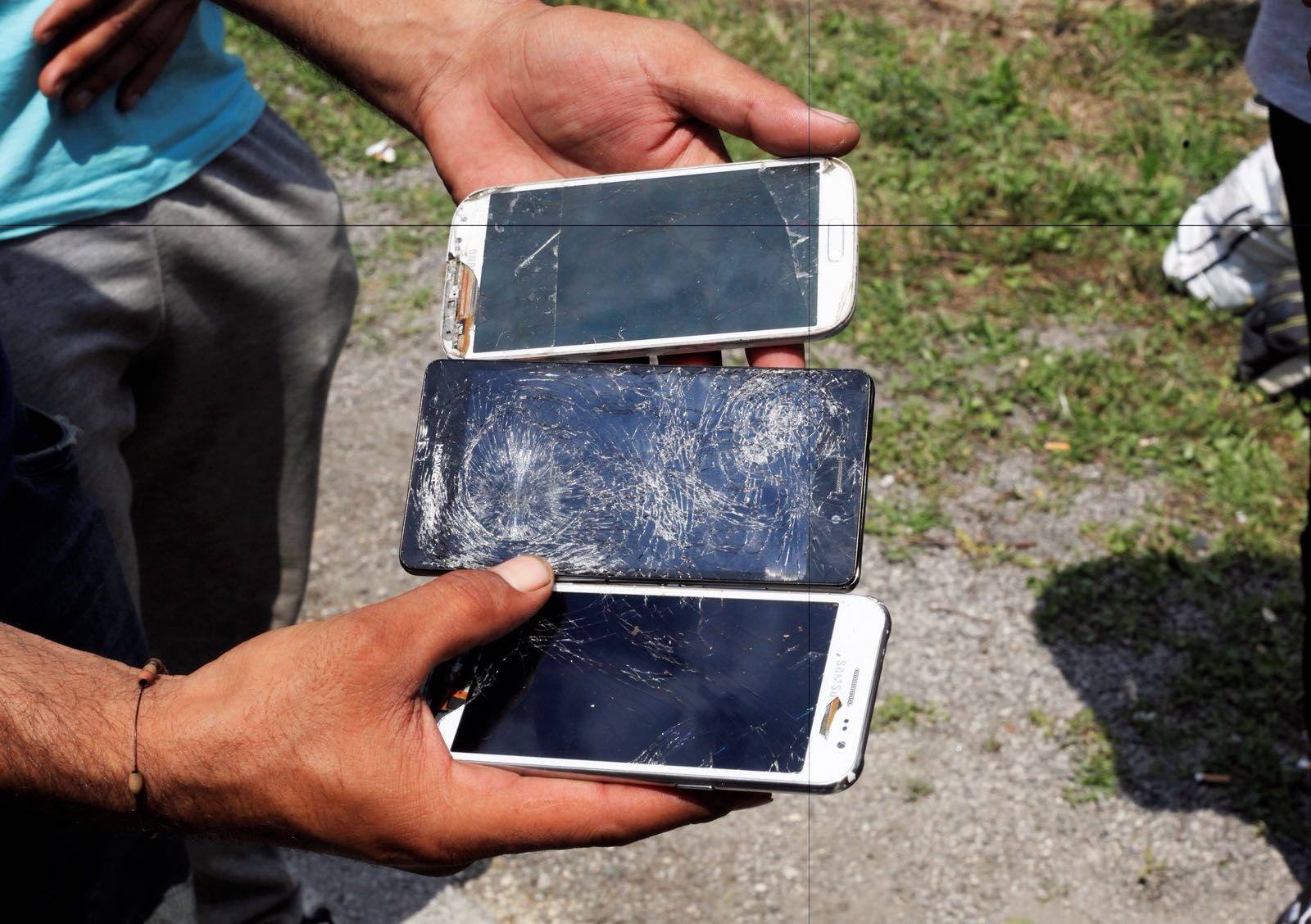
50 to 100 migrants are estimated to have been returned from Croatia to Bosnia each week during July and August 2018 in a process known as ‘push-back’. This is when the authorities prevent migrants from seeking protection on their territory and return them to the neighbouring country they have arrived from. (8) This practice is considered illegal because it undermines a refugee’s right to seek asylum as stated in international and EU law. Yet, there was little remorse amongst the Croatian authorities responsible.
On August 2018, Balkan Insight, an investigative journalism platform that covers stories in southeast Europe, reported how Davor Božinović, the Minister of Interior of Croatia, denied allegations of police violence. In July, Croatia’s Police Union, SPS, went as far as to commend the police for their attempts to guard Croatia’s external border. Some media sources have reported that Croatia’s hardline effort to protect what is the EU’s external border is motivated by its desire to show itself fit to become part of the Schengen Area, the zone made up of 26 countries which do not have internal border controls.
Croatian police violence was not the only cause of problem faced by migrants that had recently returned from ‘the game.’ “Eating leaves, eating herbs, drinking mountain water,” reported one 18-year-old Afghan from Kabul as other sources of trouble. When his rations of energy drinks and biscuits finished, he had survived five days on the journey with a sore and empty stomach. Another young Afghan, from Nangrahar, had also found himself starving. He had been waiting for an unmarked taxicab for three days in an abandoned field shelter. This period had been so dangerous for two young babies in the group that the smuggler, who was with them, deemed it safer to turn back; he led the migrants into the comparative safety of the Croatian police.
Being pushed back can be not only unpleasant but dangerous. A father of three children from Kunduz explained how his family’s push-back from Croatia to Bosnia had involved the Croatian Police forcing a total of 28 passengers into the back of a van. “I was dying, I couldn’t breathe… I have a heart problem.” With no windows or air-conditioning, his elderly father had almost fainted. Responding to the banging noises made by the migrants locked in the van, the vehicle had eventually pulled over on the side of the road to allow the passengers to breathe fresh air for five minutes.
Reaching Slovenia, but still facing difficulties
Those who travelled successfully through Croatia were likely to face new difficulties in Slovenia. The Afghans without enough money to pay smugglers knew their chances of reaching Italy were slim and as a result, some considered the idea of claiming asylum in Slovenia as a fall-back for if their attempts to get into Italy failed. These were mostly Afghans who had been stuck in Serbia since the closure of the Balkan Corridor.
During this author’s visit to Velika Kladuša between 13 and 24 July 2018, the twenty or so Afghans she met who had tried to claim asylum in Slovenia had been refused and returned to Croatia, which, in turn, had led the Croatian police to slip them over the border back into Bosnia. Several explained how unaccompanied minors (under 18 years of age) had been split from the adult members of the group. These unaccompanied minors were the only migrants who were permitted to remain in the country.
Many of the adult migrants, almost all of whom looked to be in their mid-twenties, said that, in the hours after they had told officers they wanted to claim asylum, they had been made to sign a document they did not understand at the police station. After signing this document that ‘warrants’ their removal from Slovenia, they are resultantly ‘push-backed’ into Croatia. Although, as one volunteer at No Name Kitchen (NNK) who has been collecting testimonies from migrants in Velika Kladuša says, usually, migrants do not get given a copy of the document they have signed. In one case this author saw, an Afghan from Baghlan did return to Velika Kladuša with a paper admitted by the Slovenia police. It seems that, in addition, he was given a reduced 230 Euro fine for violating Article 145 (1) of the Aliens Act, which prescribes a fine of 500 to 1,200 Euros (see here) for the “unauthorised crossing of external borders at places other than border crossing points or at times other than the fixed opening hours In Slovenia”. It is unclear how may migrants crossing illegally into Slovenia were issued this fine.
In the first four months of 2018, the Asylum Information Database (AIDA) reported that 798 asylum claims were submitted in Slovenia only in the first four months of 2018 compared to fewer than 1,500 in the whole of 2017. The report highlights how these higher numbers have put a noticeable strain on the reception centre in Ljubljana, the single facility for new arrivals in Slovenia. The higher number of asylum claims may have triggered the routine denials made to migrants to claim in recent months. On 4 July 2018, when one Afghan expressed his intention to seek asylum in a police station in the village of Stara Lipa (located on the Slovenian south-east border with Croatia), a police officer replied that “No chance to take asylum here, in Slovenia are 600 migrants and here is no space for more”.
Afghans in Bosnia: full of doubts?
This author met a handful of Afghans who had plans to return to Serbia, either wanting to return to the more familiar networks there or affected by the fragility of the situation in Bosnia. A seventeen-year-old boy from Kunar, for example, said he was planning to work backwards. The following day, he was going to take a series of buses in the direction of Visegrad, a town bordering Serbia, where he would then walk through the forest in the direction of the Serbian border, the path that he had taken in the opposite direction four weeks before. Unlike those newly arriving into Bosnia, he wanted to be seen by the border police and pushed back into Serbia. Glancing at his sleeping place reluctantly, a dirty mat on a floor scattered with onion peel and empty milk cartons, it was easy to see why he might gravitate towards the relative comforts of the Krnjača Asylum Centre in the outskirts of Serbia’s capital Belgrade. Since it was recently decided that the Obrenovac Transit Centre was unsuitable for minors, Krnjača now accommodates all new unaccompanied minors.
For other Afghans now in Bosnia, their current experience mirrors the similarly hopeless time they spent in Serbia: they know that, either way, their situation is unlikely to improve. “Bosnia is the same as Serbia, except there, we had a room and here we have a tent,” a nineteen-year old girl from Kabul explained.
One Afghan from Nangrahar, who was living in a dirty barn in Velika Kladuša with thirty or so other Afghans, described how little he had gained from relocating from Serbia into Bosnia. He had spent a combined twenty months in the two countries and was ready to give up, following a series of failed ‘game’ attempts made on foot because of his inability to pay smugglers. Unsure what to do, he knew there were very few options available to him.
He had paid 5,000 Euros to smugglers to reach this point on the journey. The fear of wasting this money, in combination with the threat of having to return to Afghanistan as ‘a failure’ were reasons to keep him in virtual limbo in Bosnia for now. (See this AAN dispatch on what awaits those who opt to return to Afghanistan). An older member of the group he was travelling with had made it his duty to make the Nangrahari continue to try to reach Italy and on into western Europe. This friend was desperate that he not waste the huge sum of money he had already spent reaching Bosnia.
In spite of the obstacles for Afghans lacking the money to pay smugglers to progress onwards into the EU, they feel they must continue to attempt ‘the game.’ The failure associated with returning to Afghanistan and the lack of social and economic opportunities in Bosnia – where 60 per cent of young people are unemployed – leaves Afghans with little option but to continue to try their luck at the border. Afghans in Velika Kladuša are stuck refugees, like those in Turkey and Greece (see this AAN dispatch about situation in Turkey).
In Velika Kladuša, migrants who have ‘gone crazy’ was often the subject of the conversations among the community. Most conversations concluded with statements about zendagi (Dari for ‘life’, also used in Pashto) and qesmet (Arabic for ‘destiny’ also used in Pashto). Almost always, Afghans referred to both when speaking about the series of borders that lay ahead of them. Some of those in Velika Kladuša said their lives were over, but if they succeeded in reaching the EU, it would start again. Their destiny was understood as something that awaited them in western Europe.
Conclusion: another blocked border to the EU?
For the many Afghans who can pay a smuggler and get an unmarked taxicab, whether they go from northern Serbia or northern Bosnia to western Europe is of little importance. A large number of those without the means to pay smugglers believe they must relocate from Serbia to Bosnia. They have some hope of successfully travelling Bosnia’s mountainous and rugged routes into Croatia. In between attempts at ‘the game’, they stroll aimlessly around town, waiting for hoped-for money transfers from friends in Europe or Afghanistan. The money will buy replacement phones, phone-credit, power-banks and energy drinks for the journey. Afghans in Bosnia, like those in Serbia, are stuck, but still endeavouring to move on.
(*) Elizabeth Wait is an aid-worker and researcher currently based in Serbia. Elizabeth went to Bosnia between 10 and 24 July 2018 where she collected the information for this dispatch.
Edited by Kate Clark and Jelena Bjelica
(1) Bosnia and Herzegovina is usually shortened to Bosnia.
(2) The 7,600 refugees and migrants who have arrived to Bosnia since January 2018 are only a fraction of the over 920,000 refugees and migrants who, according to European Commission statistics passed through Serbia on the route to the European Union in late 2015 and the first three months of 2016 (see also this AAN dossier on Afghan migration to Europe), the time when the Balkan Corridor was open.
(3) When the Balkan Corridor closed on 7 March 2016, the UNHCR recorded 1,500 trapped migrants in Serbia. The failure to open an alternative scheme to relocate them to northern or western Europe meant their number rapidly increased, as new people arrived. In December 2016, 7,000 migrants were known to be stranded in Serbia accommodated across 18 government-run asylum, reception and transit centres, 49 per cent of whom were Afghans. The UNHCR’s record of the number of migrants in Serbia across 2016 can be found here.
(4) The Asylum Information Database (AIDA) notes the breakdown of asylum applications in Serbia. In 2017, although 236 applications were submitted, just three individuals received refugee status and 11 people received subsidiary protection in Serbia. (See the report here).
The thousands of other refugees stuck in Serbia were without the legal documentation required to access the labour market or rent property and therefore were barred from building a life for themselves in the country. This desperate situation forced migrants to travel onwards to western or northern Europe. Some attempted to cross the fenced-off border with Hungary or the country’s highly guarded border with Croatia, as AAN reported in 2017 (see here). Many of those who were unable to pay the 2,000 to 3,500 Euro fee charged by smugglers to facilitate these journeys were consequently stuck in Serbia.
(5) At the time of publication, no formal statements had been released online or otherwise regarding the opening of Hotel Sedra, the new accommodation facility for refugees in the outskirts of Bihać, in northern Bosnia. International volunteers involved in the move-in process provided information informally to AAN.
(6) Besides their native language, children were usually confident practising the languages that they had learnt in either their camp or in the local school they had attended in Serbia.
(7) The names were put on the list by the Serbian Commissariat for Refugees, once the people registered at the temporary reception centers in Serbia. The list was then communicated to the so-called community leader (an asylum seeker) who is chosen by the Commissariat and who is placed in the pre-transit zone on the Serbian side of the border. The community leader then communicated the list to the Hungarian authorities. The Hungarian authorities allow people into the transit zones based on these lists and communicates the names of the people entering the transit zone in the following days to the community leader, who then informs the Commissariat who then informs the people. There was no official communication between the Hungarian and Serbian authorities on this matter. (see here and here).
(8) Oxfam in cooperation with The Belgrade Centre for Human Rights (BCHR) and the Macedonia Young Lawyers Association (MYLA) in their report, “A dangerous ‘game’. The pushback of migrants, including refugees, at Europe’s borders”, define a ‘pushback’ as:
… the term used to describe the practice by authorities of preventing people from seeking protection on their territory by forcibly returning them to another country… pushbacks violate international and EU law because they undermine people’s right to seek asylum.
To read further, see the report here.
By Special Arrangement with AAN. Original link.
Disclaimer: Views expressed on this blog are not necessarily endorsed or supported by the Center for Research and Security Studies, Islamabad.



